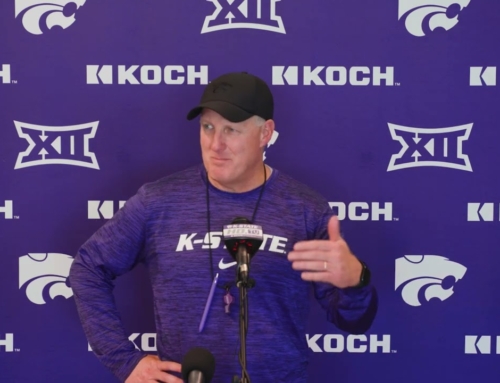* Due to the sensitive nature of highlighting specific issues or obstacles with security, response times, and other force protection matters tied to the findings of the tabletop simulation, media outlets were not given notes/documents about matters known preemptively, or after the exercise was complete. *
The Junction City Police Department conducted a tabletop simulation, in conjunction with other first responders and USD 475, in preparation for a hypothetical active shooter situation in one of the district’s schools.
Participating members were comprised of the Junction City Police Department, USD 475 School District, Geary County Sheriff’s Office, Junction City Fire Department, Geary County Emergency Management, and Grandview Plaza Police Department.
USD 475 Chief Operations Officer David Wild says the purpose of the exercise was to go through procedures that may be followed in the event of an actual event, and reestablish processes that may have been lost last year due to COVID-19.
“We haven’t been able to do a robust actual exercise, that we typically do in the district, where our emergency responder partners are also with us through those exercises,” Wild said. “So the purpose again, was so we could exercise everybody, at least intellectually and verbally, and prepare for a series of the actual exercises in the coming semester.”
Joining Wild, Junction City Chief of Police John Lamb says these events allow his officers to identify best practices, learn from them, and rethink, retool and identify deficiencies to begin to address them.
“In the event a situation does happen, we have an idea of what everybody is doing, and depending on where it is, they very well may be in the county, and we’re going to respond as a secondary,” Lamb said. “It may be in the city, whereas everybody’s coming to us. So I think those lines of communication need to be kept open, and we need to start articulating what we’re going to do. So this was a valuable exercise.”
During the overall event, in notes shared among members, Lamb and Geary County Sheriff Dan Jackson said their findings identified several areas that will require changes in case they ever face this situation.
“There was one specific area identified in today’s training, that they’re going to break off into a secondary group to deal specifically with that area,” Jackson said. “It’s a large part of this large event, important part of this event, and we identify weaknesses there and those separate groups can work on that.”
“The smaller tabletop addresses some of the deficiencies we identified, but I think the larger one is so manpower intensive, and we don’t want to impact the operations of the school. So starting to break down what that’s going to entail, then the size of the people in that role, and what that involves, do we do it during the summertime?” Lamb said. “So our goal is working together with the sheriff’s office and the school board and all the other parties involved, that ideally we’d love to see that. I think that’s that’s going to benefit everybody.”
Wild and Lamb continued by stating exercise facilitators had sought to up the critical nature of this event by inserting injects during discussions that were meant to introduce friction and potential difficulties to overcome.
“I think there was ‘Aha’ moments throughout the afternoon, where things really brief well, you can brief your protocols well, but then in an actual application, how is it really going to work?” Wild said. “That was what the outcome of this event today was, and it was very beneficial.”
“Policy only goes so far. Practice is where the rubber meets the road,” Lamb said. “Sure, not being able to do a full scale activity, the tabletop is a great start. So it keeps the interest there, and then hopefully, next year, we’ll be able to do some on a larger scale.”
Critical to the many agencies involved success is the implementation of the ALICE Program, an active shooter program implemented through two drills a year at each school.
- Alert, notify authorities and those in harm’s way of the danger at hand.
- Lockdown, or shelter in place.
- Inform, give real-time updates.
- Counter, the attacker as a last resort.
- Evacuate, or get out!
Wild indicates that staff receive annual online training of one hour per year, and received a certification from the ALICE Institute four years in a row, something Wild’s district believes sets them apart as one of the only school districts in the country to receive this certification, and more broadly is a decision-based system.
“You may have heard similar programs referred to as run-hide-fight. But what we do is try to instill in our teaching staff, our administrative staff, even down to the student level, you have options in the event there’s a crisis, and we hope to establish enough muscle memory, through drills, that those staff and students recognize that I’ve got an option here,” Wild said. “I can either escape, I can lock down and barricade in this classroom. If I’m confronted with something, we’ve trained our students, if an assailant were to walk into this room right now, we’re all captured in this room, everybody picks something up and throws it at that individual, and then as many as can escape because we all understand if you’ve got an assailant with that much stimulus coming at him or her, they’re going to flinch, that is just a natural human reaction. So again, it’s a decision option based program, very flexible, empowers every individual to hopefully make the right decisions in the actual case of an actual event.”
Lamb says in addition to the training, school resource officers are specifically taught to work to build rapport with students so that the student feels safe bringing information to them, if there’s a threat.
“It may be minor, but we want to investigate it to the fullest and ensure that it doesn’t escalate. So every SRO is given that ability to work with the children and start building that trust and that rapport,” Lamb said. “We’ve seen success from it, not so much as a school threat, but other crimes that we’ve been able to address and actually solve based on the information given to us from a student.”
Discussing whether there was any inter-agency work that the district or police agencies did with other school districts on Active Shooter situations, Lamb, Wild and Jackson said not from the law enforcement standpoint, but if called upon by another county, their staff would be loaned out to them.
“We rely heavily on the sheriff’s office and their expertise and so many other agencies rely on us for the same thing. So our goal, is to be the leading agencies in the State of Kansas,” Lamb said. “We want other agencies to come and glean from us what we’re doing, working closely with the fire department and the school board and emergency preparedness, emergency management and all those other entities that make up our county, because they realize it’s working, and we’re successful with it.”
“The district likewise, Mr. Scott Clark has been out to Littleton, Colorado three times to go through their processes and their protocols. He also hosted and took district administrators, and their secondary administrators, for the same purpose,” Wild said. “So we recognize their unfortunate experience has driven them to be one of the best school districts, in our opinion, in the nation that knows exactly how to handle these things to the best of their ability and we’ve taken lessons learned from them and implemented them over here at USD 475.”
“At the end of the day, all we’re worried about is keeping our kids safe. So we’re never going to be as strong as a sheriff’s office’s as when we partner with the school district, partner with the police department, and partner with the fire department,” Jackson said. “You’re always much better partnered, than you are by yourself. So that’s what this kind of stuff does for us.”
The post JCPD & USD 475 conduct active shooter tabletop simulation to develop prevention strategies appeared first on News Radio KMAN.





